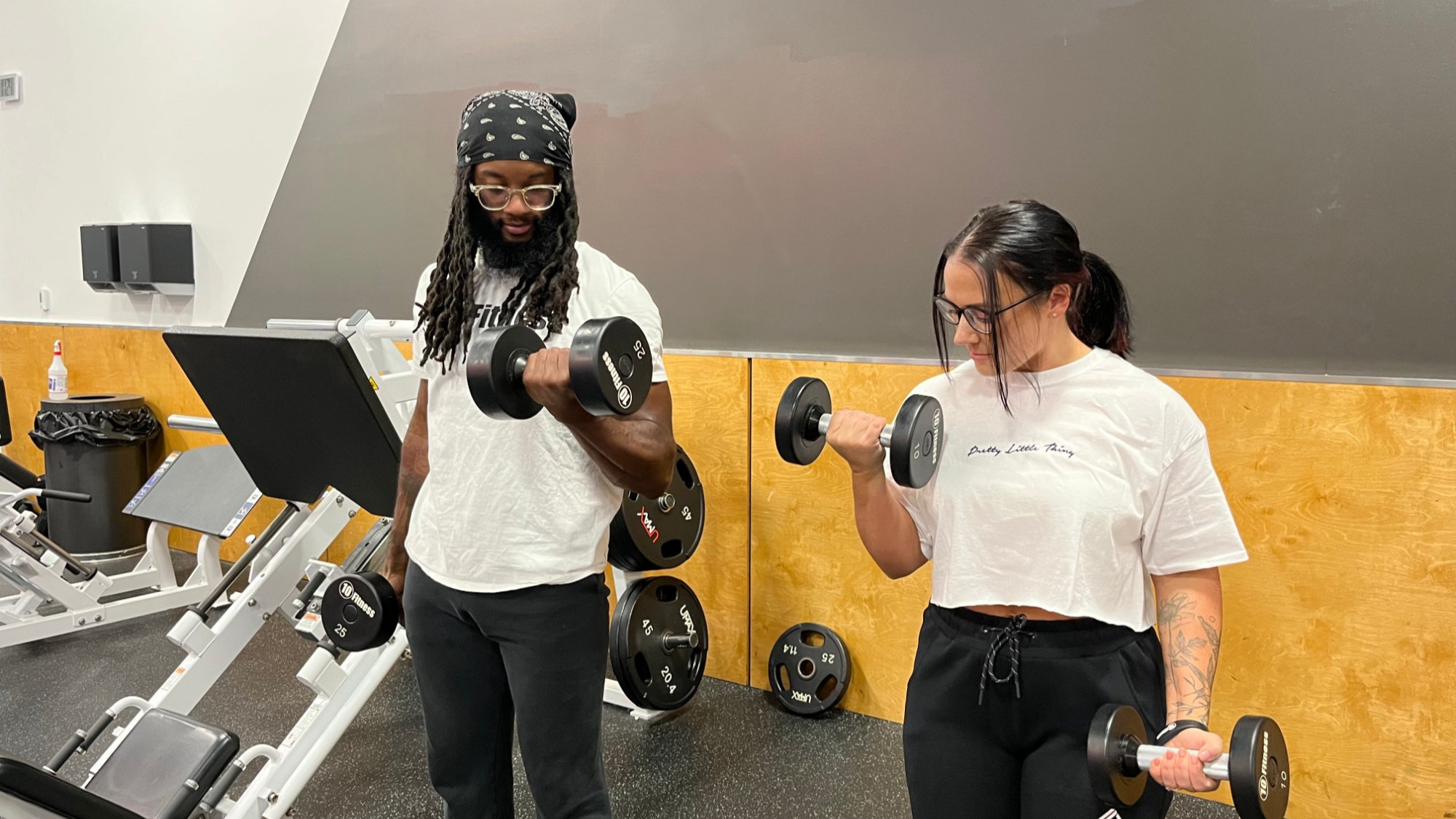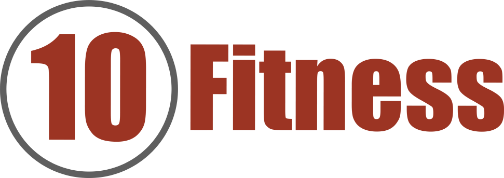
Want to feel stronger, move better, and burn more fat—without spending a fortune? Strength training is one of the best ways to build muscle, boost energy, and grow your confidence. But if you’re new to lifting weights, it can feel confusing or even intimidating. Here at 10Fitness, we’ve helped many beginners get started on a budget. We’ll show you exactly where to begin. Ready to lift smarter?
Key Takeaways:
- Strength training builds muscle, making daily tasks easier and helping burn more calories at rest
- Supports bone health, joint strength, lower blood pressure, better mood, sleep, and confidence
- Get started with basic gear: light dumbbells (3–10 lbs), bands, firm shoes, and a mat or chair
- Focus on compound movements: squats, push-ups, rows, lunges, and deadlifts
- Recommended schedule: 2–3 non-consecutive strength days weekly; rest helps build muscle
- Begin with 1–3 sets of 8–12 reps using a weight that challenges you while keeping solid form
- Add difficulty over time by increasing repetitions, weight, or intensity
- Motivation tips: build habits, work out in welcoming environments, and tie goals to personal values
Strength Training for Beginners: A Simple, Safe, and Powerful Guide to Getting Started
Strength training for beginners is undoubtedly one of the most effective ways to feel stronger, move better, and build confidence—both in and out of the gym. Although the idea of lifting weights or doing squats might initially sound intimidating, the truth is that anyone, at any age, can benefit from it. Best of all, you don’t need fancy equipment, big muscles, or even a gym membership to get started. Instead, you just need a plan, a little space, and the willingness to take that first step.
Strength Training for Beginners Builds More Than Muscle
The biggest benefit of strength training is that it makes everyday life easier. Consequently, carrying groceries, climbing stairs, or playing with your grandkids becomes less of a chore. Even a few short sessions each week can help boost energy, reduce fatigue, and improve your mobility.
Additionally, muscle burns more calories than fat, even at rest. So, when people ask why strength training helps with fat loss, the answer is simple: muscle is your body’s natural calorie burner. You don’t need hours of cardio or a strict diet. In fact, strength training alone helps you feel leaner and more toned over time.
Moreover, it supports your bones. As we age, bone density can decrease. However, lifting weights encourages bones to stay dense and strong, reducing the risk of fractures or osteoporosis. Furthermore, it also supports joint health, especially for those managing arthritis or chronic pain.
And let’s not forget your brain. According to JAMA Psychiatry, strength training may also ease symptoms of depression and anxiety. That’s because movement releases feel-good chemicals in the brain. As a result, after just a few weeks, many beginners say they sleep better, feel calmer, and think more clearly.
Lastly, strength training builds confidence. Seeing yourself get stronger—and noticing your clothes fit better or moving with more ease—can reshape how you see yourself. And that confidence, in turn, tends to stick.
Strength Training for Beginners Can Start at Home
There's no need to join a gym right away. Instead, you can begin with wall push-ups, bodyweight squats, or resistance bands. Furthermore, even lifting water jugs or canned food can be a great first step. The key, however, is to start small and stay consistent.
According to the CDC, fewer than 30% of adults meet the minimum strength training recommendation. So, just by starting, you’re already ahead of the curve.
How to Start Strength Training Safely and Confidently
As a beginner, the most important rule is to prioritize form over weight. This means using light resistance and focusing on how your body moves. Firstly, a good warm-up is essential—just 5 to 10 minutes of marching in place, arm swings, or light cycling helps get your muscles ready.
Use this checklist to maintain proper form:
- Firstly, keep your shoulders relaxed and back
- Secondly, brace your core as if you're about to be tapped in the stomach
- Next, move slowly and with control
- Finally, breathe out during the effort (like lifting), and in during the return
Moreover, always stop if you feel sharp pain or pulling. While mild discomfort is okay, pain is your body’s way of telling you something’s wrong.
Additionally, rest days are important. Aim for at least one full day off between lifting sessions, as this gives your muscles time to rebuild stronger.
What Equipment Do You Actually Need?
To begin strength training for beginners, you don’t need much. At home, all you need is:
- A light set of dumbbells (3–5 lbs for arms, 8–10 lbs for bigger moves)
- Resistance bands
- A firm mat or towel
- A chair for balance or seated exercises
Start with a weight that feels challenging by rep 10, but still allows clean form. If a move feels too easy, try adding reps or upgrading your resistance.
If you're training at the gym, most equipment is already available. Many gyms also offer beginner-friendly machines and group classes to help you learn safely.
Best Strength Training Exercises for Beginners to Try First
Focus on compound exercises—moves that work multiple muscles at once. These include:
- Squats: Great for legs and hips
- Push-ups: Strengthen chest and arms (use a wall or knees to modify)
- Rows: Build back strength (use bands or weights)
- Lunges: Improve balance and leg strength
- Glute bridges: Strengthen hips and lower back
You can also add:
- Shoulder presses
- Bicep curls
- Tricep kickbacks
- Core moves like planks or crunches
Start with 2–3 sets of 10–12 reps per move. Rest 30–60 seconds between sets. As you build confidence, add more intensity gradually.
How to Structure Your Strength Training Week
For beginners, 3 days a week is ideal. This gives your body time to recover while helping you build a habit.
Here’s a basic 3-day plan:
- Day 1: Upper body (push-ups, rows, presses)
- Then, Day 2: Lower body (squats, lunges, glute bridges)
- Day 3: Core and full-body (planks, deadlifts, combo moves)
Space workouts with a rest day in between. Try Monday, Wednesday, and Friday. If you’re short on time, even 2 days a week will bring results.
Understanding Sets, Reps, and Weight
A “rep” is one repetition of a movement. A “set” is a group of reps done in a row. Beginners doing strength training can start with:
- 1–3 sets
- 8–12 reps per set
- Light to moderate weight
Here’s how goals match your format:
- 8–12 reps = tone and fat loss
- 4–8 reps = strength and muscle building
- 12–16 reps = stamina and general fitness
Rest 30–60 seconds between sets for general health, or 1–2 minutes for muscle building.
Always choose a weight that challenges you in the last two reps, but still allows good form.
What Is Progressive Overload and Why It Matters
Once your routine feels too easy, it’s time to add a challenge—this is called progressive overload. It’s how your body gets stronger over time.
Progressive overload means:
- Adding more reps
- Using heavier weights
- Reducing rest time
- Trying harder variations (e.g., moving from wall push-ups to kneeling, then full)
Track your progress in a notebook or app. If you’ve used the same weight for weeks and it feels effortless, you’re ready to move up.
Small changes make big differences. Increase weight by 1–2 lbs or add just two more reps. Never sacrifice form for intensity.
Staying Motivated as a New Lifter
All beginners struggle at first. To stay motivated:
- Set small, action-based goals (like “work out twice this week”)
- Celebrate progress, not perfection
- Focus on how you feel, not just how you look
- Choose a supportive environment
Whether you train at home or in a gym, structure helps. Use a beginner plan, join a class, or consider a personal trainer for guidance.
Most of all, be consistent. The more you show up, the more results you’ll see—and the more you’ll want to keep going.
Sample Beginner Strength Workout
Here’s a simple, 30-minute full-body workout perfect for beginners:
Warm-Up (5–10 minutes):
March in place, arm circles, step side-to-side
Workout (2–3 rounds):
- Chair squats – 12 reps
- Wall push-ups – 12 reps
- One-arm rows (band or weights) – 10 per side
- Glute bridges – 12 reps
- Shoulder presses – 10 reps
- Bicep curls – 12 reps
- Crunches or leg lifts – 12 reps
- Back extensions – 12 reps
Cool Down:
Light stretching, deep breathing, water
Modify as needed and listen to your body. You can always start with one round and build up.
Learn and Grow with a Supportive Fitness Community
If you’re looking for a welcoming gym space that supports strength training for beginners, 10 Fitness is a great place to start. With expert trainers, friendly staff, and beginner-friendly classes, you’ll find everything you need to feel confident and strong.
Visit 10 Fitness for more resources, training tips, and tools to help you succeed.
Find Your Gym, Find Your Strength
Ready to Begin? Find a 10Fitness Location Near You
Starting strength training is easier with the right space, equipment, and community. At 10 Fitness, you’ll find expert guidance, supportive trainers, and welcoming facilities designed for everybody. Whether you're lifting for the first time or coming back after a break, your journey starts here.
Find your nearest 10 Fitness gym and take the first step toward strength and confidence.
Strength training for beginners doesn’t have to be complicated. With the right moves, smart planning, and a steady mindset, you’ll build strength, health, and self-belief. Start simple, stay consistent, and let your progress speak for itself. You’re not just lifting weights—you’re lifting your entire life.

